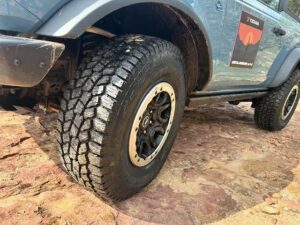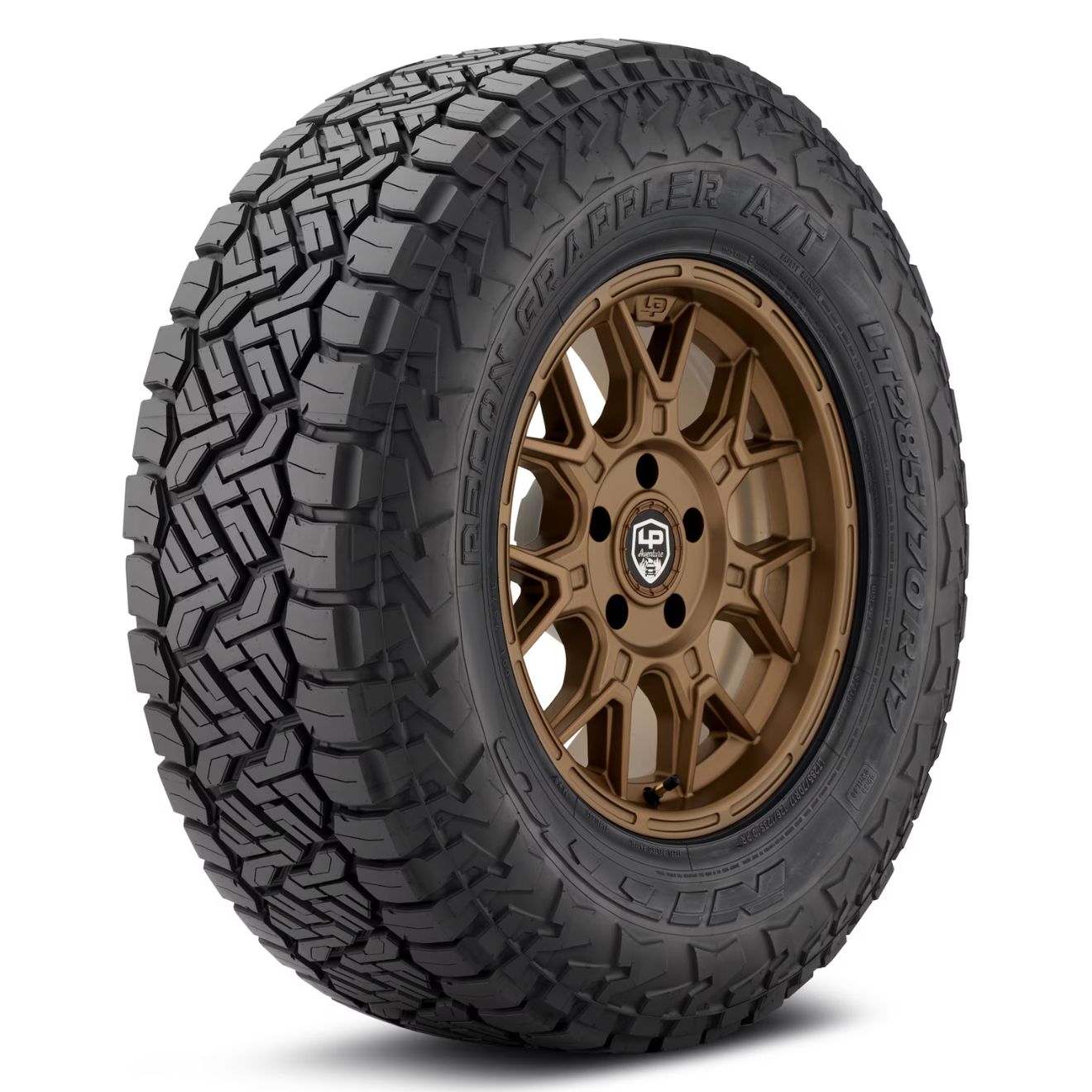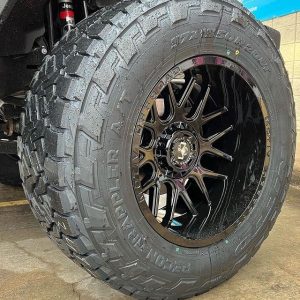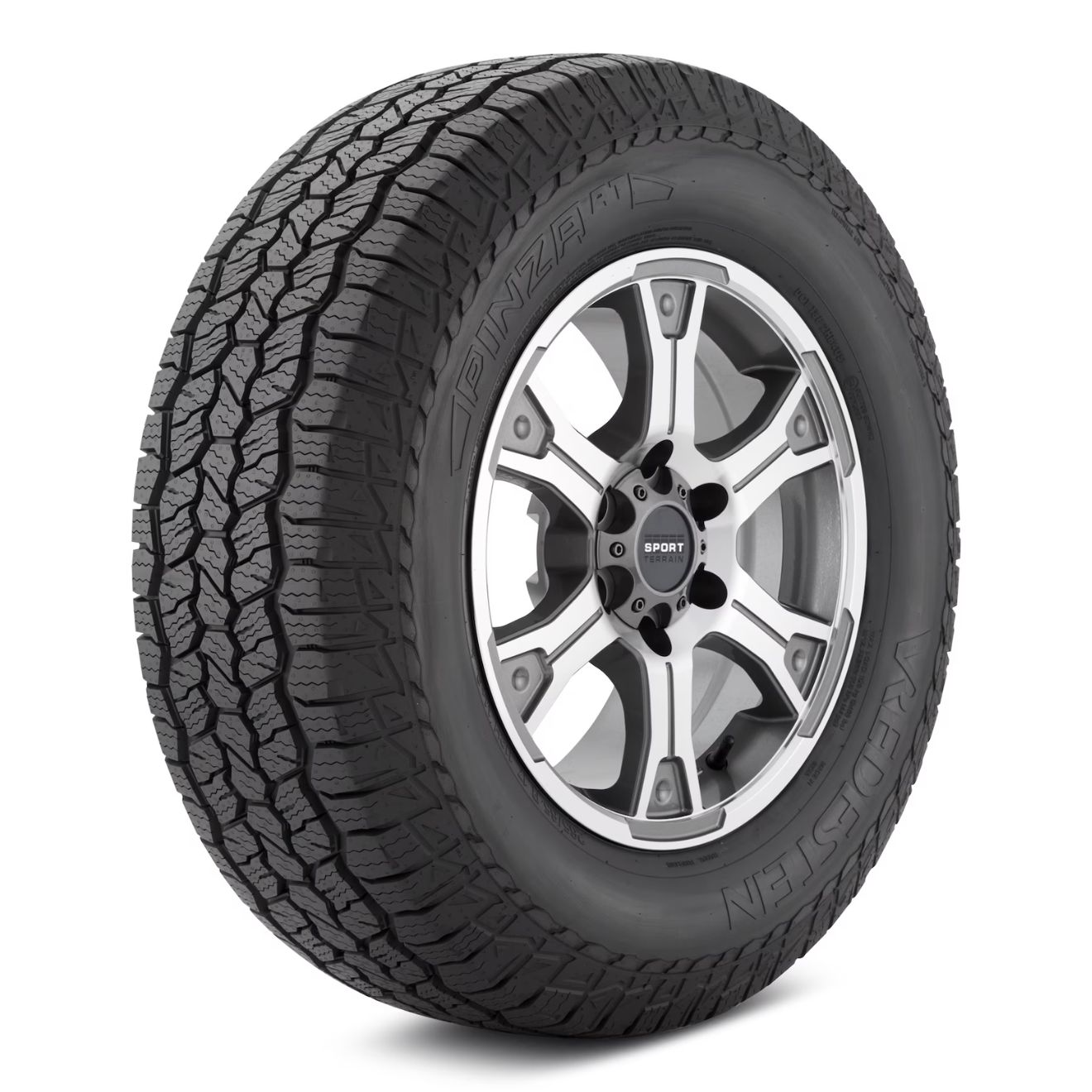Real-world test data, everyday impressions, and plain-English breakdowns — from a former Bridgestone test engineer.
The BFGoodrich KO2 has been the benchmark Off-Road A/T tire for more than a decade, trusted across the US and Canada for its 3-ply sidewalls, trail toughness, and snow-certified 3PMSF traction. The newer BFGoodrich KO3 keeps that DNA but improves snow grip, extends tread life, and sharpens handling, making it the clear evolution for drivers debating KO2 vs KO3. The Yokohama Geolandar AT4, as an On-Road AT Tire, meanwhile, enters from a different angle — emphasizing modern road manners, stronger wet and ice braking, and a lighter steering feel, while still carrying adventurous A/T styling.
That’s the choice buyers face — KO2’s proven legacy, KO3’s updated balance, or Yokohama’s road-friendly refinement. In the sections ahead, I’ll break down how they compare across dry, wet, snow, and off-road testing. You can also line them up in our All-Terrain Tire Decision Tool for quick recommendations tailored by SUV, CUV, or truck class.
Quick Look
The Yokohama Geolandar A/T4 is the comfort commuter’s all-terrain. It brakes shorter on dry and wet pavement, feels smoother in daily turns, and stays impressively quiet on the highway. With its 3PMSF rating, it surprises in winter commutes—holding its own in packed snow and light ice—while still looking the part of an A/T. Its trade-off is durability and trail grit, but for suburban drivers who value calm road manners, it’s a standout.
The BFGoodrich KO3 is the modern benchmark, balancing toughness with refinement. It grips earlier on ice than the KO2, steadies heavy rigs under towing, and shortens winter stops, while keeping its legendary off-road bite. Noise is present but livable, and its versatility makes it ideal for regions where snow, storms, and trails all collide.
The BFGoodrich KO2 remains the veteran workhorse. Louder, firmer, and longer in the wet, it still outmuscles rivals in deep snow and trail abuse. Built with armored sidewalls and proven longevity past 50k miles, it’s the tire you trust when durability is the priority and comfort is secondary.
Yokohama Geolandar A/T4
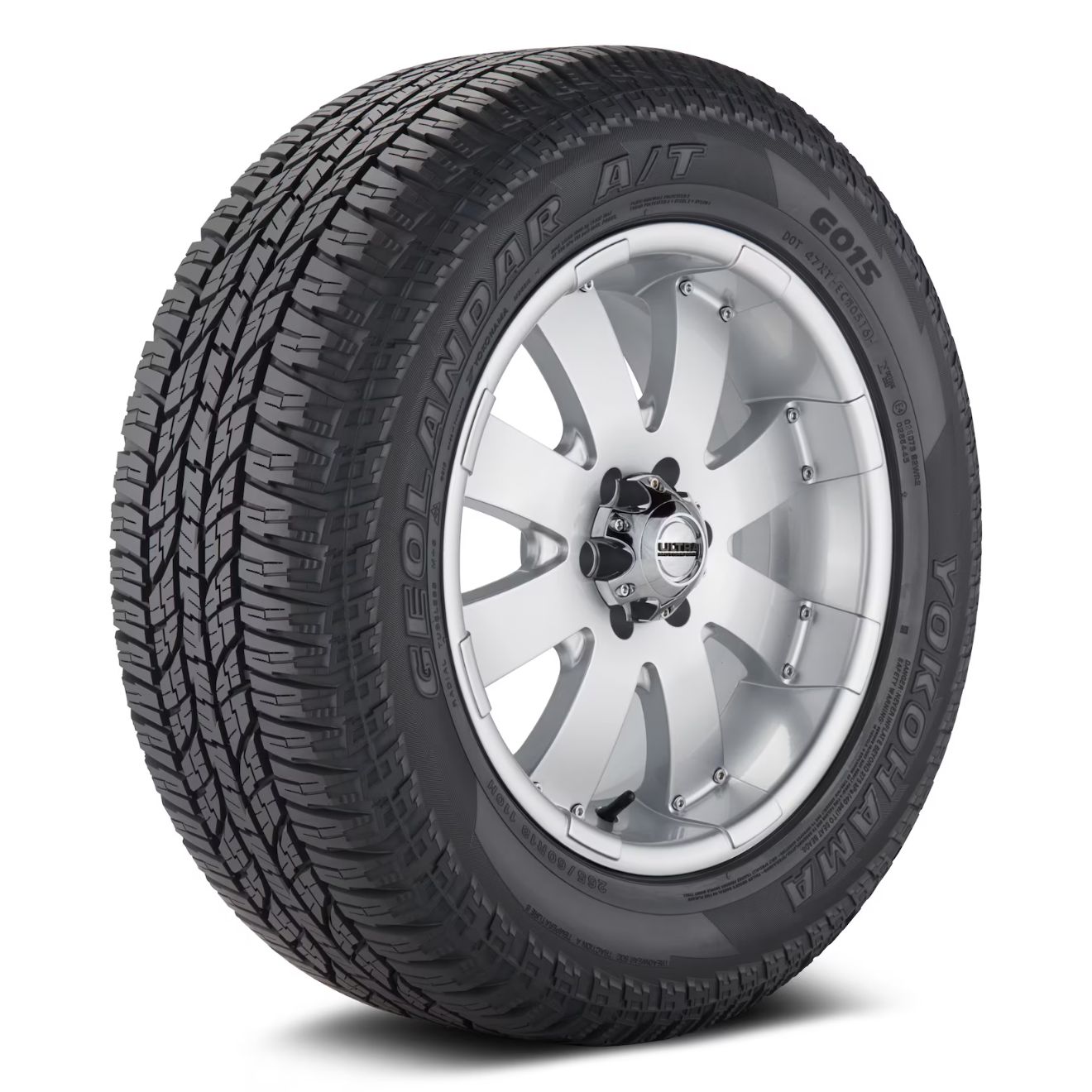
Tire Decision Tool
For those in a hurry: this tool makes it easy. Just pick your vehicle and what matters most to you, and it’ll instantly suggest the best tire options.
Raw Test Data
Tire Test Data
Pick categories to show metrics, then open ☰ to pick tires. Optional chart is hidden by default.
Dry Performance — KO3 steadies under weight, KO2 digs in, Geolandar smooths it out
On dry pavement, the Geolandar stops in about 139 feet with 0.70 g cornering, while both KO2 and KO3 take closer to 142 feet at 0.71 g. In practice, that means Yokohama feels smoother and more predictable in daily turns, while the BFGs carry more of that “rugged boot” personality. KO2 in particular feels a little sharper on initial bite, whereas KO3 takes a beat, then locks into a straighter, calmer line once weight is involved.
Drivers echo the same: Geolandar owners rave about “super smooth, quiet highway manners,” while KO2 fans talk about “planted bite when you lean in.” As a former field test engineer, I see the reason clearly—Yokohama uses balanced ribs and softer edges to keep transitions calm, while BFG’s reinforced shoulders keep the tread blocks from folding, so stability only builds once you’re loaded.
👉 Verdict: Geolandar is the commuter’s calm companion; KO2 and KO3 feel tougher, with KO3 settling heaviest rigs the straightest.
Wet Performance — Geolandar impresses, KO3 holds margin, KO2 stretches
In the rain, Geolandar surprises many: it stops in about 177 feet with 0.47 traction, which actually beats the KO2’s longer 195-foot / 0.43 g result. KO3 sits in the middle at 184 feet / 0.46 g, and while not sporty, it feels more controlled than its older brother. Behind the wheel, Yokohama gives a more composed stop on slick pavement, while KO3 keeps trucks tracking truer once you add weight. KO2, meanwhile, asks for extra space.
Owners put it in plain words: one Geolandar driver said it “handles rain nicely, with fewer slip surprises than BFGs,” while KO3 owners praised “confidence even in big storms.” KO2 comments often admit it’s “fine if you slow down, but long on panic stops.”
The trade makes sense: Yokohama’s compound and siping put more rubber down across the slick surface, while KO2 and KO3 lean harder into durability. KO3 refines it a touch, KO2 simply prioritizes toughness over adhesion.
👉 Verdict: Geolandar wins the lighter-rig wet commute, KO3 steadies things under weight, KO2 trails behind.
Note from the Expert: When it comes to rain, I always emphasize two things: compound grip and water evacuation. You can see the full details in my analysis, but if you take just one thing away, remember that an AT tire’s stiff nature makes achieving top-tier wet performance a constant battle. This is why the question, Are All-Terrain Tires Good in Rain?, requires a nuanced answer that balances tread design against rubber stiffness.
Winter & Snow — KO3 dependable on pack, KO2 a deep-snow bruiser, Geolandar the commuter surprise
On packed winter roads, KO3 shortens stops to around 72 feet, while KO2 runs a bit longer at 76 feet. Geolandar surprises here, matching KO3 almost stride for stride at 72 feet, though its launch lags slightly. The experience feels different: KO3 grips calmly on polished lanes, KO2 muscles through deeper snowbanks, and Geolandar handles morning commutes with more composure than you’d expect from a road-leaning A/T.
Drivers say the same—Geolandar owners talk about “unexpected grip in plowed snow, even compared to bigger names.” KO2 drivers praise the “tank-like shove in unplowed roads,” while KO3 owners split the difference, noting “calm, consistent traction when the highway ices up.”
Technically, the split comes from siping density and rubber mix. KO3 keeps micro-edges biting in the cold, KO2 relies on tread depth and voids to muscle through loose drifts, and Geolandar’s softer-leaning rubber stays pliable in the cold, helping it brake well on commuter roads.
👉 Verdict: KO3 is the balanced winter pick, KO2 the snow-belt brawler, and Geolandar the quiet achiever for light rigs.
Note from the Expert: Our discussions often boil down to the core tradeoff. On one hand, you must understand why all-terrain tires are truly effective in deep snow, but not on ice. On the other hand, you face the 3PMSF Paradox—the hidden cost of that badge. The short answer is: The 3PMSF badge certifies traction, but it costs you durability. Dive into our full analysis on the critical 3PMSF rating for severe winter and off-road service, and its hidden costs, before you risk your rig on the trail.
Ice — KO3 grips first, KO2 steady, Geolandar slides a touch
When things glaze over, KO3 stops shortest at about 50 feet, KO2 follows close at 51 feet, while Geolandar stretches to around 53 feet. That gap feels bigger in panic stops: KO3 gives earlier bite, KO2 slides a little longer but predictably, and Geolandar tends to wash forward more if you’re not gentle.
Community voices mirror it: KO3 drivers say “you can actually brake without panic,” KO2 users accept “longer, but always steady,” while Geolandar owners note “fine if you drive careful, but don’t rush it.”
The reason is rubber again. KO3 uses micro-siping and a compound that flexes more at freezing temps; KO2 is stiffer but still stable; Geolandar has the quieter compound but fewer micro-edges to catch slick surfaces.
👉 Verdict: KO3 is the ice safety net, KO2 a close second, Geolandar trails but remains predictable if you drive smart.
Off-Road — KO3 masterclass, KO2 still a workhorse, Geolandar a pavement-first A/T
Off-road is where the gaps widen. KO3 scores 9.5 across dirt, sand, and rock, with 9.2 in mud; KO2 trails slightly with 9.3–9.5 across the board. Geolandar? More like 6.0 in dirt, 5.5 in mud and rock. On trail, that’s the difference between a tire built to survive ruts, sharp rock, and deep mud versus one tuned for light gravel and occasional dirt roads.
Forum chatter confirms it: KO3 users rave it’s “bulletproof on rocks, confidence in deep ruts.” KO2 drivers say it “takes abuse for miles, sidewalls never fail.” Geolandar owners? “Perfect for unpaved roads to the cabin, but not for crawling.”
From a technical seat: KO2 and KO3 have thicker sidewalls, interlocking blocks, and compounds that resist chipping. Geolandar keeps weight and noise down, but with less void depth and armor, it’s not meant for heavy trail punishment.
👉 Verdict: KO3 leads, KO2 close behind, Geolandar only for mild off-road.
Note from the Expert: Every successful day on the trail is about preparation and physics, because tire longevity is earned, not given. Before you even start, you must master the critical link between tire pressure and load range for every rig to maximize your contact patch. Once moving, remember your ultimate off-road armor is your sidewall protection against the inevitable pinch flat. And finally, your traction on the obstacle is dictated by choosing the right aggressive vs hybrid tread pattern for your terrain. Master those three steps, and your rig will be ready for anything.
Comfort & Noise — Geolandar quiet as a church mouse, KO3 steady hum, KO2 the growler
On the highway, Geolandar posts the highest comfort score, about 8.5/10, riding quiet and smooth. KO3 sits middle of the road at 7.5/10, while KO2 feels rougher at 7.0/10. Think of Geolandar like a new luxury couch—plush and hushed—while KO2 is more like a solid wooden bench, firm and loud, but unbreakable. KO3 tries to split the difference.
Owners confirm it: Geolandar drivers say “dead quiet, smoother than stock,” KO3 owners admit “hum builds, but blends in on a diesel,” while KO2 users joke “you’ll hear them before you see them.”
The difference comes from design: Geolandar’s rib layout reduces resonance, KO3 uses sequencing to manage growl, KO2 simply accepts more void noise in exchange for trail grip.
👉 Verdict: Geolandar wins commuters; KO3 balances toughness with livable noise; KO2 is louder but trades that for durability.
Note from the Expert: For years, choosing all-terrain meant accepting noise—a true compromise for off-road grip. That’s why the question, Are All-Terrain Tires Louder than Highway Tires?, used to have a simple “yes” answer. Now, with the rise of on-road models, the core issue has shifted from noise to overall refinement. To fully understand which side of the comfort spectrum you’re buying into, you need to determine Are All-Terrain Tires Good for Daily Driving?—a question that depends entirely on the tire’s construction, not just the name.
Where They Fit Best + Regional Notes
Yokohama Geolandar A/T4: Best if you drive mostly highways and suburban miles, want a quiet tire, and still need 3PMSF winter confidence. Perfect for the Midwest, Southeast, and Sun Belt where off-road is rare but wet weather or mild snow shows up.
BFGoodrich KO3: The all-rounder. Stronger than Geolandar in snow, ice, and off-road, but still refined enough for daily use. Best for the Rockies, Northeast, or Great Lakes region where winter and trails both matter.
BFGoodrich KO2: The veteran workhorse. Louder and less refined, but with unbeatable toughness and deep-snow ability. Ideal for ranch country, Southwest desert, or anywhere durability outweighs comfort.
👉 Bottom line: Geolandar is the comfort commuter’s all-terrain. KO3 is the balanced modern benchmark. KO2 is the old-school bruiser that still rules when toughness is the only goal.
Tire Size Selection: The Basics You Can’t Skip
Even the best tread design can’t rescue a tire that’s built too weak. Back when I was testing tires at Bridgestone, I saw all-terrain models that should’ve performed but fell short — simply because the basics (size, load strength, and speed rating) weren’t matched to the vehicle.
P-Metric vs. LT (Light Truck) Tires
The first step is knowing whether you need LT or passenger tires. LT (Light Truck) tires are built with extra reinforcement and stiff sidewalls, designed for towing, hauling, or off-road use. Passenger (P-metric) tires are lighter, smoother, and tuned for daily comfort and fuel efficiency — but they’ll flex more under load.
Understanding Tire Load Range: XL vs. E-Load
Then comes the tire load index and load range — essentially your tire’s strength rating. Here’s where things split between passenger XL and LT E:
XL (Extra Load) is a passenger tire with reinforced sidewalls. It can handle a bit more pressure (~41 PSI) than a standard SL tire and is perfect for SUVs, crossovers, or light trucks that carry extra gear, passengers, or small trailers. XL tires ride softer and quieter than LT options, making them ideal for daily use.
E Load Range is an LT tire class built with a much thicker casing. E-rated tires can handle far more pressure (up to ~80 PSI) and heavier loads, which makes them essential for ¾-ton and 1-ton trucks towing trailers or hauling close to max capacity. The trade-off is weight, stiffer ride, more road noise, and a small drop in fuel efficiency.
Put simply: XL is for “extra luggage and family,” while E is for “truck bed full of bricks or a car trailer.”
Why the Tire Speed Rating Matters for Safety
Finally, don’t overlook the tire speed rating. It’s not just about top speed — it measures how well a tire handles heat and stress at highway pace. Lower ratings (like S) tend to ride softer and last longer, while higher ratings (H, T) feel more stable and responsive under sharp maneuvers. Heat build-up is the silent killer of tires, and speed rating is your safeguard.
Bottom line: Match your tire’s construction (LT vs P-metric), load range (XL vs E), and speed rating to your vehicle’s demands. Get those right, and everything else — off-road grip, winter traction, comfort — will finally perform the way it was designed to.
Final Verdict — Which Tire Should You Buy?
For suburban drivers who want quiet comfort and light-trail ability, the Geolandar A/T4 is the commuter’s pick. It surprises in the wet, holds its own in mild snow, and stays hushed on highways, making it ideal for Midwest, Southeast, and Sun Belt climates.
The BFGoodrich KO3 is the all-rounder for mixed use. It steadies heavy trucks, performs reliably in snow and ice, and remains the masterclass off-road without punishing comfort. The KO2 remains the toughest workhorse—best for ranch roads, Southwest deserts, or deep-snow rural areas where durability and raw traction matter more than refinement.
👉 Bottom line: Geolandar is the comfort commuter’s A/T, KO3 is the balanced benchmark for modern rigs, and KO2 is the proven bruiser when toughness trumps everything else.
Frequently Asked Questions: Yokohama Geolandar A/T4 vs BFGoodrich KO2 vs KO3
Which tire is quietest on the highway?
Geolandar is the quietest with an 8.5/10 comfort score, KO3 runs a steady hum at 7.5/10, and KO2 is loudest at 7.0/10.Which tire performs best in wet conditions?
Geolandar stops shorter at 177 ft, KO3 follows at 184 ft, and KO2 stretches to 195 ft, making Geolandar the wet commuter winner.Which tire is strongest in snow?
KO3 stops at 72 ft and is the balanced snow pick, KO2 digs better in deep drifts, and Geolandar surprises with solid packed-snow braking for a road-leaning A/T.How do they compare on ice?
KO3 stops shortest at 50 ft, KO2 follows close at 51 ft, and Geolandar lags at 53 ft, though it remains predictable with careful driving.Which tire is better off-road?
KO3 leads with 9.5 scores across dirt, sand, and rock, KO2 stays nearly as strong, and Geolandar is best kept to gravel and light trails.Who should buy the Geolandar A/T4?
Drivers who value quiet comfort, predictable wet braking, and light winter security, especially in suburban or mild climates.Who should buy the KO3?
Drivers needing a balanced A/T for snow, ice, and serious off-road work—especially in the Rockies, Northeast, and Great Lakes regions.Who should buy the KO2?
Truck owners in rugged, rural, or snow-belt areas who prioritize toughness and deep-snow grip over comfort and noise.


